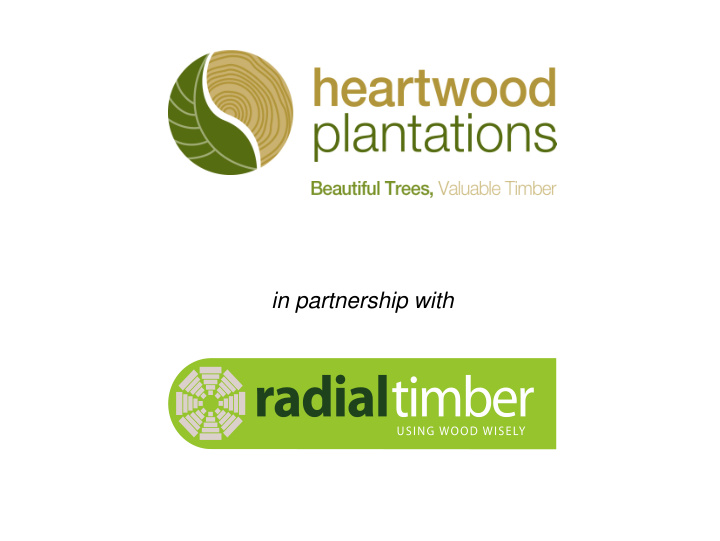



in partnership with
Growing High Value Timber Jon Lambert, Heartwood Plantations.
Our organisation - forestry • Plantation size (10 - 250 ha); • Each investment privately owned; • Trees pruned and thinned; • Total area of approximately 4,000 hectares; • Predominantly located in Gippsland; • First plantings in 1998.
Our organisation - processing • Eucalyptus logs currently sourced predominantly from native forests; • Processed at radial sawmill with ideal size 40-50 cm; • Annual cut of 5,000 m 3 year -1 increasing to 15,000; • New sawmill in Yarram to be operational by the end of 2016.
New Yarram Sawmill
Our organisation - Sales • High demand for durable appearance products; • Our products are very stable because of the species and sawing strategy; • Strong Australian markets in external appearance products; • Treated softwood now has health concerns.
Our Organisation - Structure
Key Innovations • Radial sawing technology – the only one of its type in the world; and • Plantation grown, naturally durable Australian hardwood timber.
Radial Sawing
Radial Sawing - Continued
Radial Sawing - Continued Advantages: • Much higher recovery of wood; • Back sawing - Higher value products from young trees; • Timber more stable; and • Capability to deal with young eucalypts.
Naturally Durable Australian Hardwood • Primary species are spotted gum and yellow stringybark; • Silvertop ash and red mahogany also grown; • Class 1 or 2 durability (15- 40 years above ground without treatment); • Appearance and colour highly desirable; • Strength, hardness, etc...
Naturally Durable Australian Hardwood - cont • Approximately 1 million hectares of hardwood plantations in Australia; • Currently less than 5% are durable species (class 1 or 2); • Most of this timber comes from native forest and imports; • Unique in Southern Australia;
The Key Challenges! • Industry fall out; • Investment length; • High up front cost; • Trail blazing; and • Lack of R&D.
Areas of Focus - Genetic Improvements • Faster growth; • Improved form; • Insect & disease resistance; • Early age heartwood formation; and • Wood quality.
Areas of Focus – Land Utilisation • Combine with livestock; • Cropping in easements; • Apiary opportunities; and • Lifestyle.
Areas of Focus – Nutrition • Understanding tree nutrient levels; • Differences between species; • Uptake in trees; • Application methods; and • Micro biology.
Areas of Focus – Drone Technology • • Assessment of tree health; Monitoring; and • • Mapping; Reporting.
Areas of Focus – Harvesting • • Equipment options; Optimisation; and • • Timing and strategy; Self-loading trucks
Areas of Focus – New Products • Particular need for products from thinning operations; • Firewood and pulpwood provide very low returns; • Important to bring returns earlier in the rotation.
Areas of Focus – BioEnergy • There are heat and power needs to run the sawmill; • These would be met by a fraction of our residues; • Power back to the grid is low return; • The best outcome would be a partnership.
Development work in Africa • Our non-profit foundation is called Beyond Subsistence • It p rovides training and support in agroforestry; • Currently we are working in 5 African countries; • Empowering subsistence farmers;
The End!
Recommend
More recommend